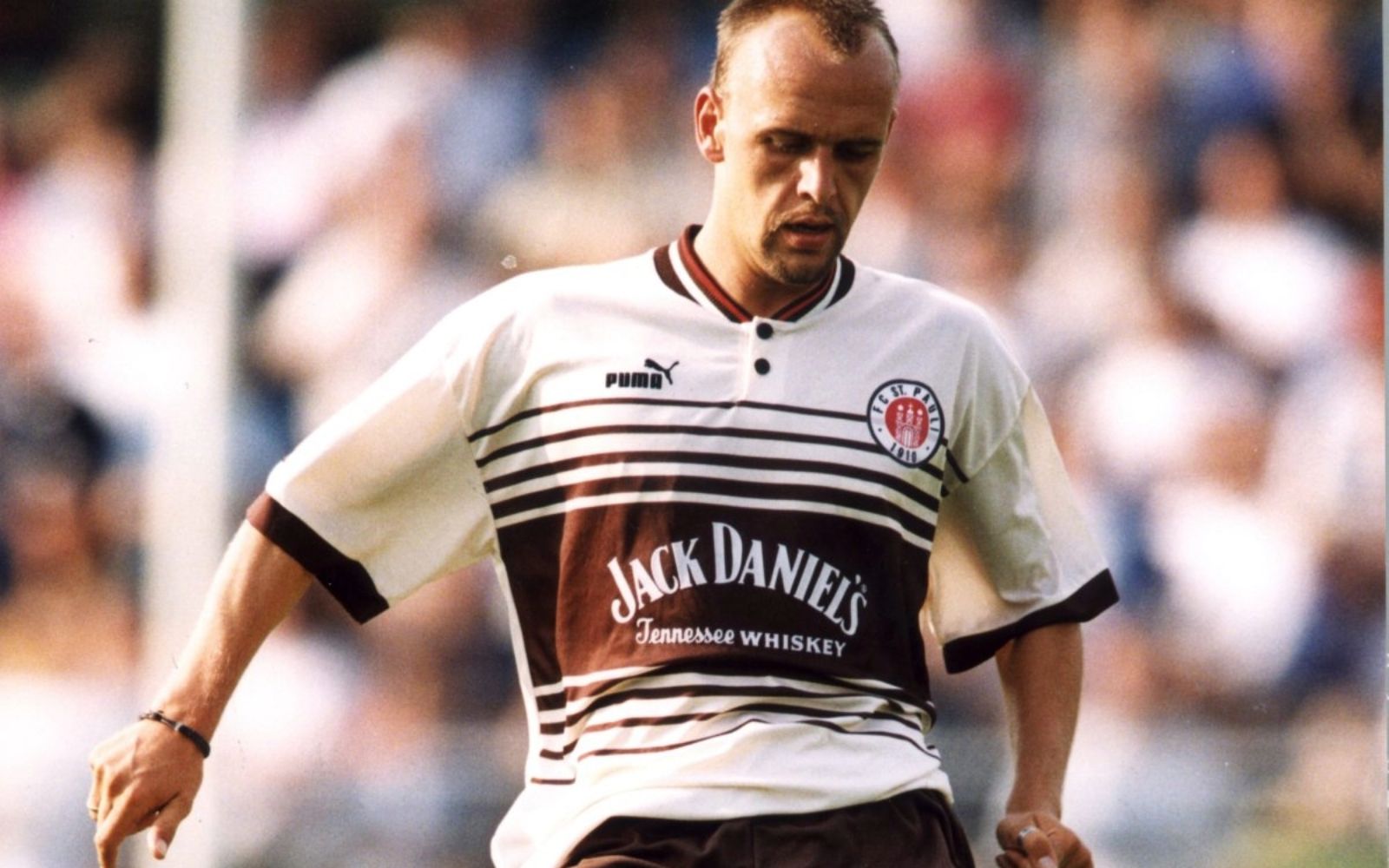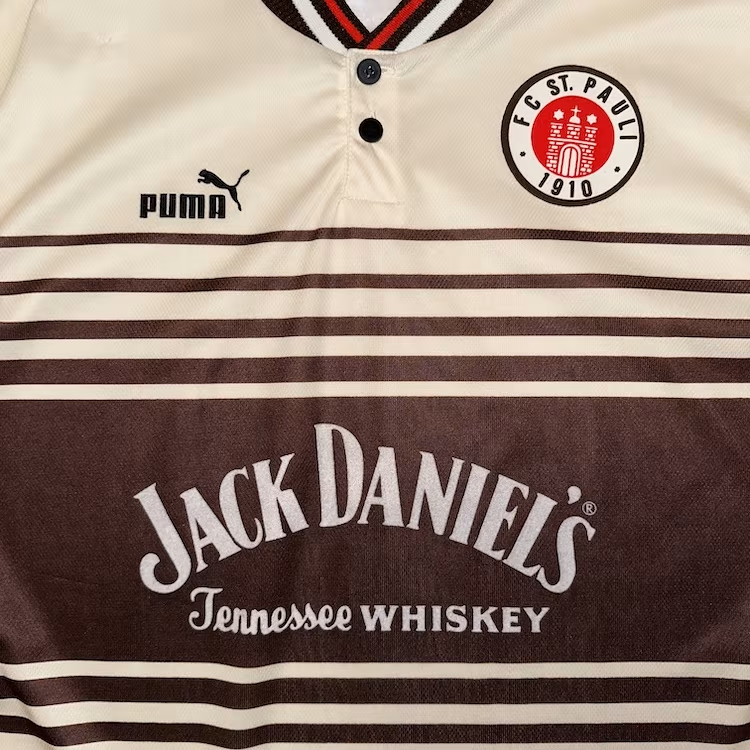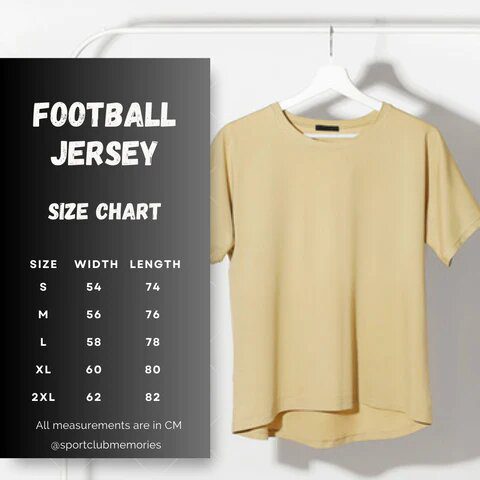
Among the flood of football shirts released in the 1990s, few captured the imagination quite like FC St. Pauli’s 1997/98 Jack Daniel’s jersey. This was no ordinary kit. It was a visual manifesto — a declaration that football could belong to outsiders, dreamers, and rebels.
The sight of a whisky logo emblazoned across the chest of a second-division German club might sound strange today, but back then, it made perfect sense. St. Pauli wasn’t chasing mainstream approval. They were building an identity — one rooted in defiance, authenticity, and a little bit of chaos.
Founded in 1910 in Hamburg, St. Pauli grew up in the shadow of larger clubs like HSV, but it refused to play by anyone else’s rules. The brown and white colors, once considered plain or even unattractive, became badges of pride. The skull-and-crossbones flag, adopted by fans in the 1980s, symbolized everything St. Pauli stood for — solidarity, anti-fascism, and rebellion.
In the 90s, St. Pauli’s terraces became a cultural movement. The club officially banned racist and sexist symbols from its stadium, decades before other clubs even considered it. Its supporters mixed punk, left-wing activism, and grassroots energy, creating one of the most distinctive fan scenes in Europe.
In that context, a Jack Daniel’s logo didn’t look like a marketing gimmick — it looked like a toast to independence.
In 1997, St. Pauli signed a sponsorship deal with the Tennessee whisky brand Jack Daniel’s — an audacious choice that quickly became iconic. The partnership lasted until 2000 and perfectly fit the club’s outlaw image. It was raw, ironic, and completely against the sanitized direction professional football was heading.
At a time when teams were sponsored by banks, airlines, and tech firms, St. Pauli wore a whisky label. It was the perfect act of defiance — and a brilliant stroke of subcultural branding.
German football in the late 1990s was changing fast: new TV deals, more commercial influence, and a growing gap between rich and poor clubs. For St. Pauli, this deal wasn’t just financial survival — it was identity armor. They turned their chest sponsor into a cultural statement: “We don’t belong to your world — and that’s our strength.”
Produced by Puma, the 1997/98 home jersey stayed true to the club’s minimalist DNA. The white base, combined with brown horizontal stripes and a clean collar line, gave the shirt a timeless silhouette.
But the centerpiece, of course, was the Jack Daniel’s Old No. 7 logo — rendered in bold black typography across the chest. It dominated the shirt, unapologetic yet perfectly balanced. The contrast between the sober design and the rebellious sponsor created an instant cult classic.

Every element — from the subtle sleeve cuffs to the small Puma cat on the shoulder — spoke of restraint, letting the symbolism do the talking. This wasn’t a flashy 90s design; it was cool, underground, and self-aware.
Today, original 1997/98 jerseys are extremely rare. Many were worn until the fabric gave out, others were lost to time. On sites like WorthPoint or Classic Football Shirts, they appear occasionally — often fetching high three-figure prices.
For collectors, it’s not just about aesthetics; it’s about what this shirt represented. It’s a conversation piece — part football history, part cultural rebellion. Owning it means owning a fragment of Europe’s underground football scene.
Beyond football, the shirt found a second life in fashion editorials, streetwear styling, and documentaries about fan identity. The combination of a whisky brand and a socially conscious club created a paradox that still fascinates designers and sociologists alike.
In a world obsessed with corporate polish, the St. Pauli 1997/98 Jack Daniel’s kit remains a symbol of imperfection, honesty, and attitude.
If you’re drawn to football’s rebellious side — if you see the game as more than trophies and scoreboards — this jersey speaks your language.
At Sport Club Memories, we celebrate kits that tell stories.
👉 Explore our St. Pauli Collection or browse Retro German Club Jerseys to own your piece of alternative football heritage.
Wear it. Feel it. Keep the rebellion alive.
More than 25 years later, the FC St. Pauli 1997/98 Jack Daniel’s shirt remains one of the most iconic kits ever produced — not because of success on the pitch, but because of what it stood for.
It’s a reminder that football isn’t just a business; it’s a culture. And culture thrives on those who dare to be different.
Wearing this jersey isn’t about nostalgia alone — it’s about carrying forward the same fearless attitude that made St. Pauli more than a club.
Discover our collection of limited-edition retro football shirts, inspired by legendary kits and unforgettable eras.
